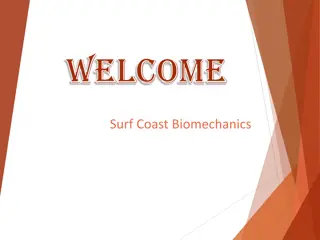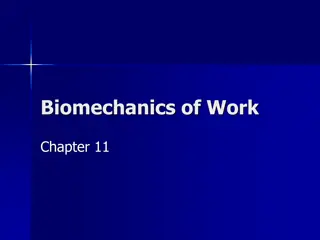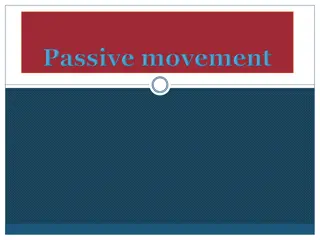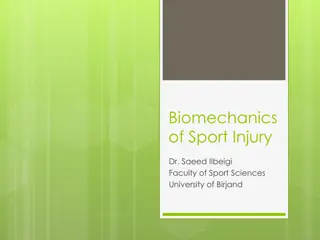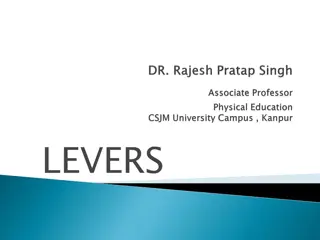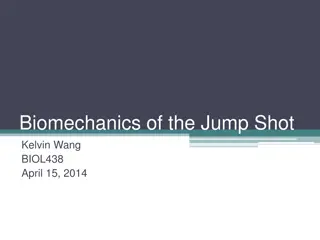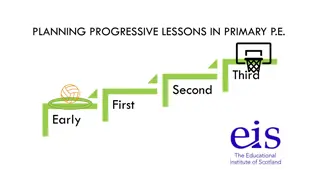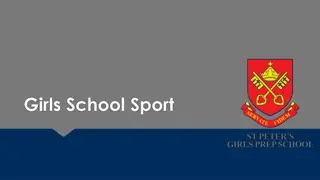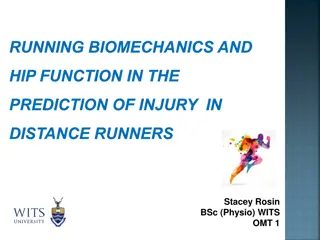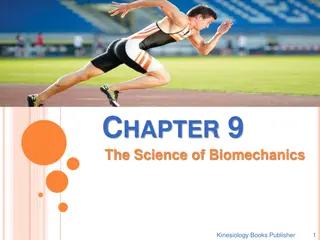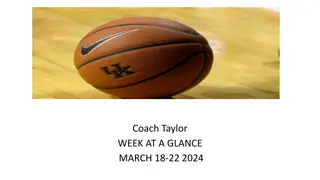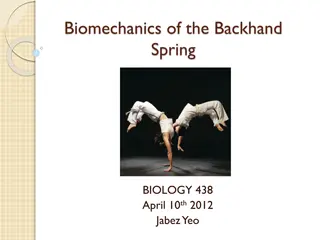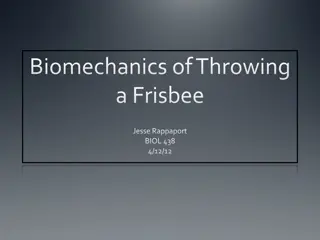Biomechanics in Physical Education: Movement Analysis Overview
Biomechanics plays a crucial role in understanding movement and technique in physical education. This resource focuses on topics such as muscular contractions, lever systems, planes and axes of movement, and sports technology. It helps sports performers and coaches analyze movements for performance enhancement and tactical understanding. Levers, muscular contractions, and their types are explained in detail, along with components of a lever system.
Download Presentation

Please find below an Image/Link to download the presentation.
The content on the website is provided AS IS for your information and personal use only. It may not be sold, licensed, or shared on other websites without obtaining consent from the author. Download presentation by click this link. If you encounter any issues during the download, it is possible that the publisher has removed the file from their server.
E N D
Presentation Transcript
WJEC GCSE in Physical Education Biomechanics: Movement analysis
Background This PowerPoint resource covers four biomechanics topics for the WJEC GCSE in Physical Education. It relates to the third key area Movement analysis.
Content This topic Movement analysis includes the following content. Muscular contractions Lever system Planes and axes of movement Sports technology There is also a Task section at the end containing questions and answers related to information within this presentation.
Overview Biomechanics is often thought as the science underlying technique. Sports performers and coaches usebiomechanicalanalysis to help improve performance, technically and tactically, as well as to help understand how and why the body moves the way it does.
Muscular contractions
Muscular contractions Muscles contract across joints to cause movement. Muscles work in pairs and when one muscle contracts the opposite muscle relaxes (antagonisticmuscleaction).
Muscular contractions Muscles contract in different ways to produce movement. Isotonic contraction: the muscle producing the tension controls the speed of contraction. Concentric contraction shortening of muscle. Eccentric contraction lengthening of muscle. Isometriccontraction: the muscle producing the tension but staying the same length.
Lever system
Levers Knowledge of levers develops an understanding of howthebodymoves and explains the interaction of the skeletal system to create movement. Levers allow us to create movement that is greater than the force applied.
Components of a lever system Levers are made up of the following three components. Fulcrum (pivot): the point at which the lever rotates (pivots) around. Effort (force): the location where the force (effort) is applied. Load (resistance): the location of the load/weight that is being moved/lifted. There are threeclassifications of lever. Class 1 lever. Class 2 lever. Class 3 lever.
Class 1 lever Load Fulcrum Load Effort Effort Fulcrum Fulcrum Examples: Neck extension. Heading a ball. Rowing. Load Effort
Class 2 lever Effort Fulcrum Load Effort Load Fulcrum Effort Examples: Standing heel lift. Ankle plantarflexion, e.g. marking in netball. Fulcrum Load
Class 3 lever Effort Load Effort Load Fulcrum Fulcrum This is the lever most commonly used in sport and movement. Effort Load Examples: Bicep curl. Knee flexion, e.g. kicking. Fulcrum
Joints and articulations Knowledge of the skeletal system and how it works helps us to understandmovement and explain how skills are performed. Knowledge of the possible movements at each joint can help coaches to understand skilldevelopment and performance improvement. Tennis elbow
Joints Skeletal joints are classified according to their structural and functional (range and type of movement) characteristics. There are three structural classifications of joints: fixed (fibrous) cartilaginous synovial.
Synovial joints The characteristics of synovial joints are: the most common joint in the human skeletal system have a joint cavity articulating bones held together by ligaments highlymoveable. Examples: Shoulder. Knee.
Structure of synovial joints Synovial joints are made up of the following. Synovial cavity a fluid-filled space that separates the articulating bones. Synovial fluid fluid that lubricates the joint and nourishes the articular cartilage. Articular cartilage hyaline cartilage covers the articulating surfaces, reduces friction and acts as a shock absorber. Ligaments connect bone to bone and stabilise the joint. Tendons connect bone to muscle and enable movement.
hinge gliding pivot Types of synovial joint condyloid saddle ball and socket The hinge and ball and socket joints are the most commonly used in sport, e.g. shoulder and knee.
Hinge joint A hinge joint is uni-axial (like a door hinge) flexion and extension. It allows movement in one plane. Examples: Ulno-humeral. Inter-phalangeal.
Ball and socket joint A ball and socket joint is tri-axial. It allows movement in three planes, e.g. flexion/extension, abduction/adduction, rotation. It is the most mobile type of joint. Examples: Hip. Shoulder.
Planes and axes of movement
Planes and axes of movement Why is it important to be able to describe movement? Understand technique. Develop ideal technical model of performance. Understand injury mechanisms. Understand the movements that contribute to successful performance. Communication of technique: coach performer.
Planes of movement Plane: a flat surface; any two points on the plane can be joined with a straight line without intersecting the plane. Plane of motion: there are three imaginary anatomical planes that intersect at the body s centre of gravity dividing the body into equal portions.
Anatomical planes of motion Sagittal plane Frontal plane Transverse (horizontal) plane
Frontal plane An imaginary vertical plane that divides the body into equal front and back (anterior and posterior) portions. Frontal plane Example: Cartwheel.
Sagittal plane An imaginary vertical plane that divides the body into equal left and right portions. Sagittal plane Example: Back flip.
Horizontal/transverse plane An imaginary horizontal plane that divides the body into equal upper and lower portions. Horizontal plane Example: Discus throw.
Planes of motion Most movements in sport occur in multiple planes. However some movements are more planar (in one plane) than others. When movement is in one plane it means that no part of the body crosses from one side of the plane to the other during the movement.
Axes of motion There are three imaginary anatomical axes that intersect at the body s centre of gravity. Motion happens around these axes. In most sporting actions, movement is about more than one axis. Longitudinal axis Transverse axis Frontal axis
Longitudinal axis An imaginary pole that runs vertically through the body from top to bottom and is perpendicular to the ground. Example: Full twist.
Transverse axis An imaginary pole that runs horizontally through the body from side to side (laterally). Example: Somersault.
Frontal axis An imaginary pole that runs horizontally through the body from front to back. Example: Cartwheel.
Movement patterns In order to understand sporting performance we need to be able to describe the movement of the human body. Using the planes and axes of movement and jointactions we can describe performance and understand the way people move.
Flexion/extension Flexion and extension happen in the sagittal plane. Flexion: the closing of a joint. Extension: the opening of a joint. Flexion Extension
Abduction/adduction Abduction and adduction involve moving limbs away from and towards the midline of the body in the frontal plane. Abduction: moving limbs away from the body. Adduction: moving limbs towards the body. Adduction Abduction
Circumduction Circumduction describes circularmotion and is a combination of flexion, extension, abduction and adduction.
Rotation Rotationdescribes twisting movement in the transverseplane, usually about the longitudinalaxis.
Sports technology
Sports technology Technology affects almost every aspect of sport from performance on and off the field to spectating and public profile. Increasingly advances in technology influence grass roots sport as well as elite sport.
Technological developments Technology applied to physical activity has played an important role both in training and competition. This is evident in a variety of ways including the creation of new sports facilities, the equipment used, officiating, spectating, coaching and performing (analysis and training). Materials technology Clothing Equipment Materials Officiating Facilities Coaching Technological developments ICT Safety features Performance analysis Training technology
Analysis of performance There are a number of methods which can be used by the coach or athlete to analyseperformance which include the following. Physical attributes Time/motion analysis. Distance covered. Testing/training. Technique Video analysis. Movement patterns and phases. Technical aspects. Behaviour Psychological profiling. Predicting behaviour. Motivation, stress, arousal. Tactics Notational analysis. Monitoring trends in performance. Systems.
Tasks: Questions and answers
Task: Question 1. How would you describe this movement in terms of planes and axes of motion? Back handspring
Task: Answer 1. During a back handspring, movement is in the sagittalplane about the transverseaxis. Back handspring
Task: Question 1. What is the joint action during these movements? At the elbow during a tennis forehand. At the knee when kicking a football.
Task: Answer 1. The joint action at the elbow during a tennis forehand = Flexion. The joint action at the knee when kicking a football = Extension.
Task: Questions What is the movement in the following skills? 1. Cricket bowling. What plane is the movement mainly in? What is the joint action at the shoulder? 2. Hammer throw. What plane is the movement mainly in? Around what axis is the performer rotating? 3. Bicep curl. What is the joint action at the elbow?
Task: Answers 1. Cricket bowling. Movement is mostly in the frontal plane. The joint action at the shoulder is circumduction. 2. Hammer throw. Movement is mostly in the transverse plane. The performer is rotating about their longitudinal axis. 3. Bicep curl. The joint action at the elbow is flexion.
Task: Question 1. What classification of lever is an elbow?
Task: Answer 1. An elbow is a Class 3 type lever. This is the most commonly used lever in sport and movement.







